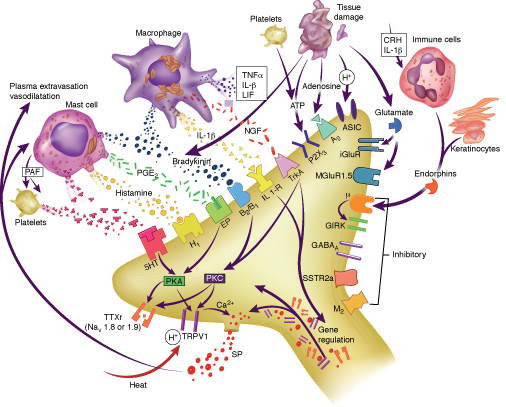Cellular Mechanism Underlying Nociceptor Sensitization Induced by Peripheral Inflammation

(From Reves JG, Fragen RJ, Vinik HR, et al. Midazolam: pharmacology and uses. Anesthesiology. 1985;62:310-324, with permission.)
Activated immune cells (macrophages, mast cells, and other immune cells) and injured cells release numerous chemicals, which may directly or indirectly sensitize the peripheral nerve terminals. A2, adenosine A2 receptor; ASIC, acid-sensing ion channel; B2/B1, bradykinin receptor B2/B1; CRH, corticotropin-releasing hormone; EP, E-prostanoid receptor; GIRK, G protein-coupled inward rectifying potassium channel; H1, histamine H1 receptor; iGluR, ionotropic glutamate receptor; IL-1, interleukin-1; mGluR, metabotropic glutamate receptor; NGF, nerve growth factor; P2X3, purinergic receptor P2X ligand-gated ion channel 3; PAF, platelet-activating factor; PGE2, prostaglandin E2; PKA, protein kinase A; PKC, protein kinase C; SP, substance P; SSTR2A, somatostatin receptor 2A; TNF-, tumor necrosis factor ; TrkA, tyrosine kinase receptor A; TRPV1, transient receptor potential vanilloid receptor 1; TTXr, tetrodotoxin-resistant sodium channel; μ, mu-opioid receptor; M2, muscarinic receptor; 5HT, serotonin; LIF, leukemia inhibitory factor.